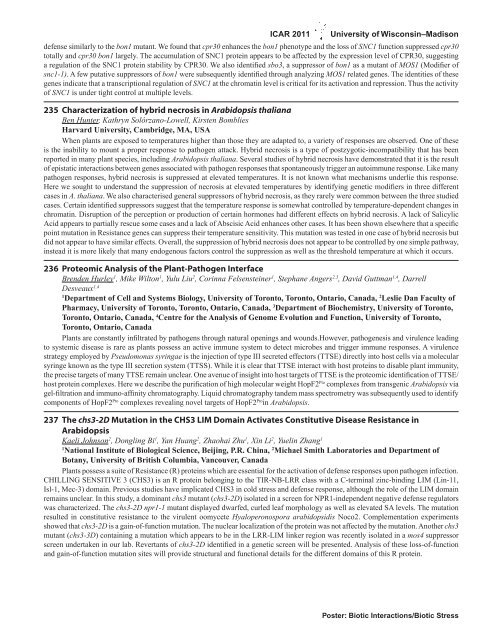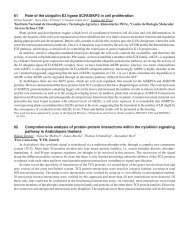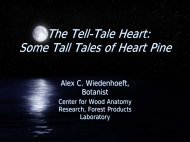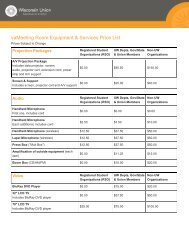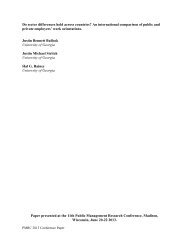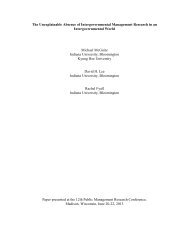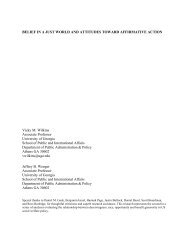Full Abstract Book - Wisconsin Union - University of Wisconsin ...
Full Abstract Book - Wisconsin Union - University of Wisconsin ...
Full Abstract Book - Wisconsin Union - University of Wisconsin ...
Create successful ePaper yourself
Turn your PDF publications into a flip-book with our unique Google optimized e-Paper software.
ICAR 2011<br />
<strong>University</strong> <strong>of</strong> <strong>Wisconsin</strong>–Madison<br />
defense similarly to the bon1 mutant. We found that cpr30 enhances the bon1 phenotype and the loss <strong>of</strong> SNC1 function suppressed cpr30<br />
totally and cpr30 bon1 largely. The accumulation <strong>of</strong> SNC1 protein appears to be affected by the expression level <strong>of</strong> CPR30, suggesting<br />
a regulation <strong>of</strong> the SNC1 protein stability by CPR30. We also identified sbo3, a suppressor <strong>of</strong> bon1 as a mutant <strong>of</strong> MOS1 (Modifier <strong>of</strong><br />
snc1-1). A few putative suppressors <strong>of</strong> bon1 were subsequently identified through analyzing MOS1 related genes. The identities <strong>of</strong> these<br />
genes indicate that a transcriptional regulation <strong>of</strong> SNC1 at the chromatin level is critical for its activation and repression. Thus the activity<br />
<strong>of</strong> SNC1 is under tight control at multiple levels.<br />
235 Characterization <strong>of</strong> hybrid necrosis in Arabidopsis thaliana<br />
Ben Hunter, Kathryn Solórzano-Lowell, Kirsten Bomblies<br />
Harvard <strong>University</strong>, Cambridge, MA, USA<br />
When plants are exposed to temperatures higher than those they are adapted to, a variety <strong>of</strong> responses are observed. One <strong>of</strong> these<br />
is the inability to mount a proper response to pathogen attack. Hybrid necrosis is a type <strong>of</strong> postzygotic-incompatibility that has been<br />
reported in many plant species, including Arabidopsis thaliana. Several studies <strong>of</strong> hybrid necrosis have demonstrated that it is the result<br />
<strong>of</strong> epistatic interactions between genes associated with pathogen responses that spontaneously trigger an autoimmune response. Like many<br />
pathogen responses, hybrid necrosis is suppressed at elevated temperatures. It is not known what mechanisms underlie this response.<br />
Here we sought to understand the suppression <strong>of</strong> necrosis at elevated temperatures by identifying genetic modifiers in three different<br />
cases in A. thaliana. We also characterised general suppressors <strong>of</strong> hybrid necrosis, as they rarely were common between the three studied<br />
cases. Certain identified suppressors suggest that the temperature response is somewhat controlled by temperature-dependent changes in<br />
chromatin. Disruption <strong>of</strong> the perception or production <strong>of</strong> certain hormones had different effects on hybrid necrosis. A lack <strong>of</strong> Salicylic<br />
Acid appears to partially rescue some cases and a lack <strong>of</strong> Abscisic Acid enhances other cases. It has been shown elsewhere that a specific<br />
point mutation in Resistance genes can suppress their temperature sensitivity. This mutation was tested in one case <strong>of</strong> hybrid necrosis but<br />
did not appear to have similar effects. Overall, the suppression <strong>of</strong> hybrid necrosis does not appear to be controlled by one simple pathway,<br />
instead it is more likely that many endogenous factors control the suppression as well as the threshold temperature at which it occurs.<br />
236 Proteomic Analysis <strong>of</strong> the Plant-Pathogen Interface<br />
Brenden Hurley 1 , Mike Wilton 1 , Yulu Liu 2 , Corinna Felsensteiner 1 , Stephane Angers 2,3 , David Guttman 1,4 , Darrell<br />
Desveaux 1,4<br />
1<br />
Department <strong>of</strong> Cell and Systems Biology, <strong>University</strong> <strong>of</strong> Toronto, Toronto, Ontario, Canada, 2 Leslie Dan Faculty <strong>of</strong><br />
Pharmacy, <strong>University</strong> <strong>of</strong> Toronto, Toronto, Ontario, Canada, 3 Department <strong>of</strong> Biochemistry, <strong>University</strong> <strong>of</strong> Toronto,<br />
Toronto, Ontario, Canada, 4 Centre for the Analysis <strong>of</strong> Genome Evolution and Function, <strong>University</strong> <strong>of</strong> Toronto,<br />
Toronto, Ontario, Canada<br />
Plants are constantly infiltrated by pathogens through natural openings and wounds.However, pathogenesis and virulence leading<br />
to systemic disease is rare as plants possess an active immune system to detect microbes and trigger immune responses. A virulence<br />
strategy employed by Pseudomonas syringae is the injection <strong>of</strong> type III secreted effectors (TTSE) directly into host cells via a molecular<br />
syringe known as the type III secretion system (TTSS). While it is clear that TTSE interact with host proteins to disable plant immunity,<br />
the precise targets <strong>of</strong> many TTSE remain unclear. One avenue <strong>of</strong> insight into host targets <strong>of</strong> TTSE is the proteomic identification <strong>of</strong> TTSE/<br />
host protein complexes. Here we describe the purification <strong>of</strong> high molecular weight HopF2 Pto complexes from transgenic Arabidopsis via<br />
gel-filtration and immuno-affinity chromatography. Liquid chromatography tandem mass spectrometry was subsequently used to identify<br />
components <strong>of</strong> HopF2 Pto complexes revealing novel targets <strong>of</strong> HopF2 Pto in Arabidopsis.<br />
237 The chs3-2D Mutation in the CHS3 LIM Domain Activates Constitutive Disease Resistance in<br />
Arabidopsis<br />
Kaeli Johnson 2 , Dongling Bi 1 , Yan Huang 2 , Zhaohai Zhu 1 , Xin Li 2 , Yuelin Zhang 1<br />
1<br />
National Institute <strong>of</strong> Biological Science, Beijing, P.R. China, 2 Michael Smith Laboratories and Department <strong>of</strong><br />
Botany, <strong>University</strong> <strong>of</strong> British Columbia, Vancouver, Canada<br />
Plants possess a suite <strong>of</strong> Resistance (R) proteins which are essential for the activation <strong>of</strong> defense responses upon pathogen infection.<br />
CHILLING SENSITIVE 3 (CHS3) is an R protein belonging to the TIR-NB-LRR class with a C-terminal zinc-binding LIM (Lin-11,<br />
Isl-1, Mec-3) domain. Previous studies have implicated CHS3 in cold stress and defense response, although the role <strong>of</strong> the LIM domain<br />
remains unclear. In this study, a dominant chs3 mutant (chs3-2D) isolated in a screen for NPR1-independent negative defense regulators<br />
was characterized. The chs3-2D npr1-1 mutant displayed dwarfed, curled leaf morphology as well as elevated SA levels. The mutation<br />
resulted in constitutive resistance to the virulent oomycete Hyaloperonospora arabidopsidis Noco2. Complementation experiments<br />
showed that chs3-2D is a gain-<strong>of</strong>-function mutation. The nuclear localization <strong>of</strong> the protein was not affected by the mutation. Another chs3<br />
mutant (chs3-3D) containing a mutation which appears to be in the LRR-LIM linker region was recently isolated in a mos4 suppressor<br />
screen undertaken in our lab. Revertants <strong>of</strong> chs3-2D identified in a genetic screen will be presented. Analysis <strong>of</strong> these loss-<strong>of</strong>-function<br />
and gain-<strong>of</strong>-function mutation sites will provide structural and functional details for the different domains <strong>of</strong> this R protein.<br />
Poster: Biotic Interactions/Biotic Stress


